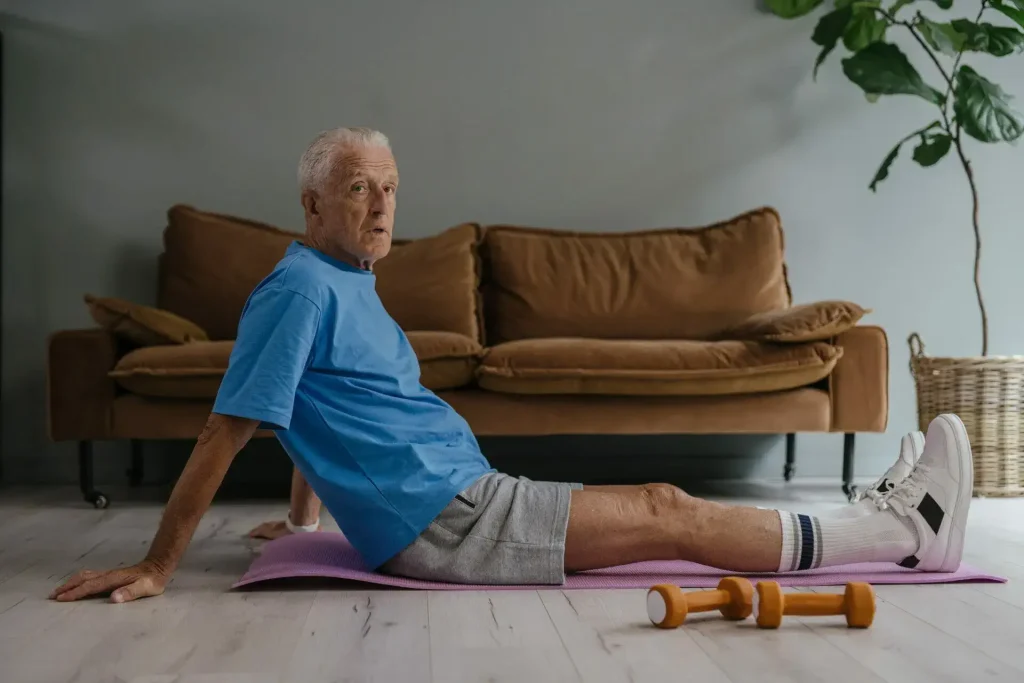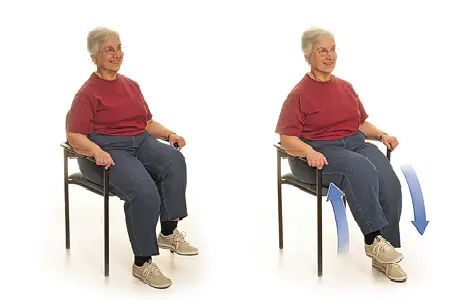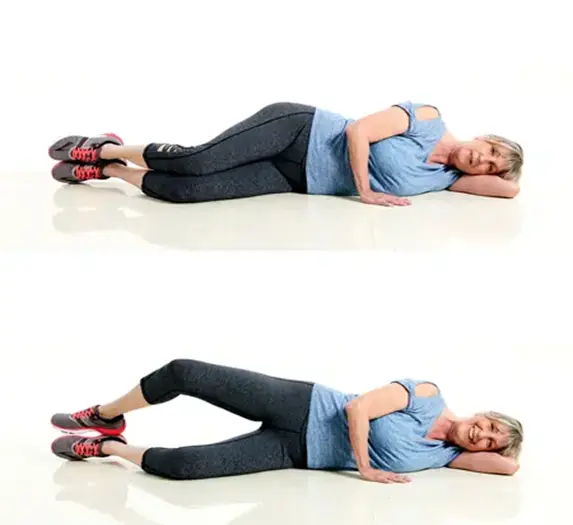
6 Leg Exercises in Bed for Elderly | Simple & Effective
Leg exercises in bed for the elderly are a simple yet effective way to maintain muscle strength and flexibility, especially those who are unable to perform heavy physical activities for various reasons. As we get older, we may decrease our physical activity and pay less attention to exercise and movement. Experiments have shown that joint stiffness and pain found in elderly people are often not caused by arthritis, but by inactivity.
For this reason, stretching is necessary to strengthen leg muscles in the elderly along with hip joint exercises for the elderly. Strengthening the muscles supporting the pelvis can help stabilize the legs and spine. A weak or unstable hip joint puts the knee, hip, and lumbar spine at risk of injury, pain, weakness, and reduced mobility. Thigh strengthening exercises can even help relieve hip and knee pain in the elderly. As we said in the article upper body workout for elderly, having proper physical activity is very important for older people because it helps them to be active and live a healthy life.
Leg exercises in bed for the elderly that we introduce in this article from the humanhealthmag, will create endurance, increase balance and coordination of body movements; in addition to strengthening the strength of leg muscles in the elderly, reducing the risk of falling and improving mobility.
Leg Exercises in Bed for Elderly: 6 Exercises to Strengthen Thigh Muscles
Note: If you haven’t done much physical activity for a long time, before you start leg exercises in bed for the elderly, see your doctor and do a complete examination to know the health status of your body and heart. Take this issue seriously. For exercises that require a chair, choose one that is stable, sturdy, and without wheels. Avoid choosing chairs that have handles as this will restrict your movement. Try to do these exercises at least twice a week.

1- Sit-to-Stand
Sit-to-stand exercise helps to strengthen gluteal muscles. It’s similar to a standing squat, except it uses a chair to protect your knees. This exercise will improve your ability to squat safely and prevent falls when using the toilet, cleaning, or other movements that require bending at the knees and hips.
To do this exercise: Sit on a chair with a firm surface (using a soft chair or couch makes it harder to stand). Bend your body forward so that your nose is in line with your toes. Use your legs to push yourself off the chair. Try not to use your hands to push on the armrests and then stand up using your glutes. Hold this position for a second, then push your hips back and slowly sit back on the chair. Repeat this movement 10 times and then rest. You can repeat this exercise in three sets of 10.

2- Seated Walking Workout
This exercise is especially important for moving the legs forward when walking and climbing the stairs. To do this exercise, sit on a firm chair and bend your knees and place the soles of your feet on the floor. Raise one leg, bring your knee close to your chest. Hold for a second, then lower. Repeat this movement for the other leg. Alternately for both legs, perform 10 repetitions on each side. You can do these 10 repetitions three times for each leg. Just remember to rest for 1 minute after every 10 repetitions in a row for both legs.

3- The Bridge Movement
Sufficient traction in the hip joint allows the foot to push forward to move forward when performing movements such as walking, climbing stairs, and standing up from a sitting position. Bridge exercise improves leg stability by strengthening hip and thigh muscles while performing these movements.
To perform these leg exercises in bed for the elderly: Lie on your back and bend your knees. Contract your buttock muscles and lift your butt. Keep your back straight and do not arch your back. Hold your hips up for three seconds, then lower them. Repeat this movement 10 times and then rest. You can repeat this exercise in three sets of 10.

4- Standing Leg Extension
Another thigh joint exercise that strengthens the gluteal muscles is the standing thigh extension exercise. In addition to strengthening the buttock muscles, this exercise also improves the strength of the core trunk muscles to better support the spine. To do this exercise:
Rest your hands on the back edge of the chair or against a wall, table, counter. Stand up straight and lift your left leg backwards. Try not to bend your knees or allow your back to arch while performing this movement. Hold this position for one second, then return to the starting position. Repeat this exercise for the other leg. You can do these 10 repetitions three times for each leg. Just remember to rest for 1 minute after every 10 repetitions in a row for both legs.

5- Clamshell Exercise
This leg exercise in bed for the elderly helps strengthen the gluteal muscles, especially the gluteus medius, which is located on the sides of the hips and supports and stabilizes the pelvis and improves balance. To do this exercise: Lie on your back with your knees bent and a resistance band placed around your thighs and above your knees. Then open one of your knees outwards. Stay in this position for three seconds, then return your knees to the previous position. Do this movement for 10 repetitions. Then rest. You can do a total of three sets of 10 of this exercise.
If you want to make these leg exercises in bed for the elderly more challenging, do the following step:
Lie on your side and bend your knees. Keep your ankles together and then lift your top knee up. Don’t allow your body or hips to roll back during this movement. Hold this position for three seconds, then lower your knee. Repeat this movement for 10 times, then change your side. You can repeat this exercise in three sets of 10 for each side.

6- Side-Lying Leg Lift
This exercise helps to strengthen the gluteus medius muscles located on the sides of the hips. Strengthening hip abduction allows you to easily move to the side during daily activities, get in or out of a car, and perform other side-to-side movements. Place your hands on the back edge of the chair. Lift your left leg to the side until there is no pressure on you. Keep your back and hips straight while performing this movement. Avoid tilting to the right and try to keep your posture straight. Stay in this position for a few seconds and then return to your first position. Now repeat this action for your right leg. Repeat this action 5 times for each leg.
How to Do Leg Exercises in Bed for Elderly Safely?
The leg exercises in bed for elderly included in this article have been chosen with the aim of being done safely and easily at home. If you find that any exercise causes you pain or discomfort, avoid it and try a different one. For example, if standing is difficult for you, start with exercises that are done while sitting or lying down. This way, you can strengthen your muscles in a more comfortable position before doing standing exercises.
It may also be helpful to perform standing exercises next to a stationary object, such as a railing, table, or chair, that can be used for support. As you progress through your hamstring exercises, focus on keeping your hips straight. Avoid any unnecessary rotation at the hips, as this can be harmful to your joints and reduce the effectiveness of the exercises.
Concluding Remarks
The leg exercises in bed for elderly plays an important role in movement health and prevention of early disability and accidents such as falls. It is very important for the elderly to strengthen these muscles and their hip joints to reduce the risk of falling. In addition, hip exercises can reduce pain and stiffness caused by arthritis and other joint diseases and maintain sufficient strength and mobility for everyday activities. By performing the above exercises along with observing ergonomics and maintaining correct posture in different situations, you can prevent many musculoskeletal pains and discomforts.

FAQs About Leg Exercises in Bed for Elderly Safely
What are the Benefits of Leg Exercises in Bed for Elderly?
Leg Exercises in Bed for Elderly can help stabilize the legs and spine by strengthening the muscles that support the pelvis. A weak or unstable hip joint puts the knee, hip, and lumbar spine at risk of injury, pain, weakness, and reduced mobility. By strengthening the hip joint, you can provide a stable and balanced base for your legs to help stabilize them during movements such as standing or walking. Thigh strengthening exercises can even help relieve hip and knee pain in the elderly.
When Should You See a Doctor?
If you have significant pain, stiffness, or inflammation in your hips and thighs, you should see a doctor to address your symptoms, make a possible diagnosis, and refer you to physical therapy if necessary.
